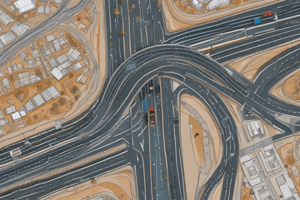Podcast
Questions and Answers
What is the primary sense through which we perceive the world?
What is the primary sense through which we perceive the world?
- Sense of touch
- Sense of smell
- Sense of taste
- Sense of sight (correct)
In what condition can eyes alone not see any object?
In what condition can eyes alone not see any object?
- In foggy weather
- In bright sunlight
- In dim light
- In complete darkness (correct)
What is necessary for seeing an object?
What is necessary for seeing an object?
- Vision correction glasses
- Light from the object entering the eyes (correct)
- Focused attention
- Good memory recall
What changes the direction of light that falls on it?
What changes the direction of light that falls on it?
What activity is described in the text for understanding the laws of reflection?
What activity is described in the text for understanding the laws of reflection?
What makes an object visible according to the text?
What makes an object visible according to the text?
What role does a mirror play in relation to light?
What role does a mirror play in relation to light?
What happens when you close all but one opening in a comb and hold it perpendicular to a sheet of paper?
What happens when you close all but one opening in a comb and hold it perpendicular to a sheet of paper?
What does a shiny surface act as according to the text?
What does a shiny surface act as according to the text?
What can be concluded about seeing an object when its light enters our eyes, according to the text?
What can be concluded about seeing an object when its light enters our eyes, according to the text?
Flashcards are hidden until you start studying
Study Notes
Primary Sense Perception
- The primary sense for perceiving the world is vision, facilitated mainly by the eyes.
Conditions for Eyes Not Seeing
- Eyes alone cannot see objects in complete darkness; light is essential for visibility.
Requirements for Seeing
- For an object to be seen, light must reflect off the object and enter the eyes.
Direction Change of Light
- Light direction is altered by reflection when it encounters a surface.
Understanding Laws of Reflection
- An activity to grasp the laws of reflection involves demonstrating how light bounces off surfaces, emphasizing angles.
Visibility of Objects
- An object becomes visible when it reflects light into our eyes.
Role of Mirrors
- Mirrors serve to reflect light, allowing images to be seen through the bouncing of light rays.
Experiment with Light and Comb
- Closing all but one opening in a comb and holding it perpendicular to paper produces a pattern of light and shadow, showcasing how light can be controlled.
Shiny Surfaces and Light
- A shiny surface acts as a reflective surface, enhancing visibility by directing light toward the observer.
Conclusion of Seeing an Object
- Seeing an object relies on the light reflected from it reaching our eyes, confirming the essential role of this light in perception.
Studying That Suits You
Use AI to generate personalized quizzes and flashcards to suit your learning preferences.




